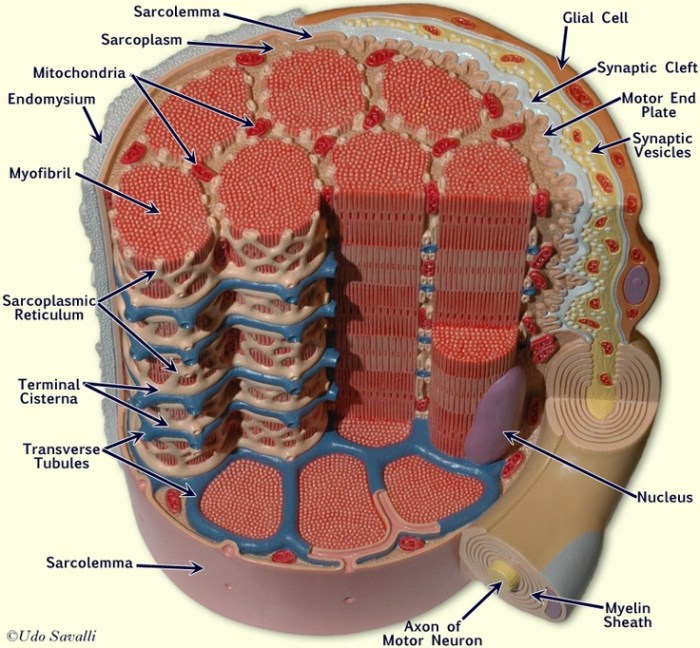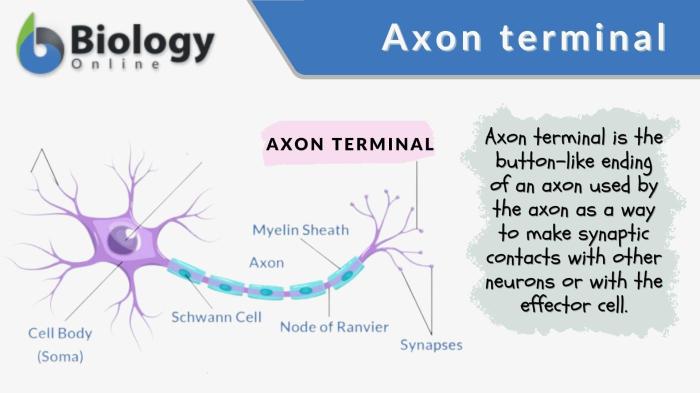Label the features of a neuromuscular junction. – Labeling the features of a neuromuscular junction is a crucial step in understanding the intricate communication between nerves and muscles. This guide delves into the structural and functional aspects of this vital connection, providing a comprehensive overview for students, researchers, and healthcare professionals.
The neuromuscular junction, a specialized synapse, enables the transmission of electrical signals from motor neurons to muscle fibers, initiating muscle contraction. Understanding its components and their roles is essential for grasping the mechanisms of muscle control and movement.
Neuromuscular Junction Structure

The neuromuscular junction (NMJ) is the site of communication between motor neurons and muscle fibers. It consists of three main components: the presynaptic motor neuron, the synaptic cleft, and the postsynaptic muscle fiber.
The presynaptic motor neuron is responsible for releasing neurotransmitters that trigger muscle contraction. It has an axon that branches out into synaptic boutons, which contain the neurotransmitter release machinery. The synaptic cleft is a narrow space between the presynaptic and postsynaptic membranes, which allows for the diffusion of neurotransmitters.
The postsynaptic muscle fiber is the target of the neurotransmitter release and is responsible for converting the chemical signal into a mechanical response.

Presynaptic Features

The presynaptic motor neuron is responsible for releasing neurotransmitters that trigger muscle contraction. It has an axon that branches out into synaptic boutons, which contain the neurotransmitter release machinery. The synaptic boutons are filled with vesicles containing neurotransmitters, which are released into the synaptic cleft when an action potential reaches the presynaptic terminal.
The release of neurotransmitters is triggered by the influx of calcium ions through voltage-gated calcium channels. When an action potential reaches the presynaptic terminal, it causes the opening of voltage-gated calcium channels, allowing calcium ions to enter the cell. The increase in intracellular calcium concentration triggers the fusion of vesicles with the presynaptic membrane, releasing neurotransmitters into the synaptic cleft.
Synaptic Cleft
The synaptic cleft is a narrow space between the presynaptic and postsynaptic membranes, which allows for the diffusion of neurotransmitters. It is filled with extracellular fluid and contains enzymes that break down neurotransmitters after they have been released.
The synaptic cleft plays an important role in the termination of neurotransmitter action. After neurotransmitters are released from the presynaptic terminal, they diffuse across the synaptic cleft and bind to receptors on the postsynaptic membrane. Once bound to receptors, neurotransmitters trigger a cascade of events that lead to muscle contraction.
However, the action of neurotransmitters is terminated by enzymes in the synaptic cleft that break them down.
Postsynaptic Features: Label The Features Of A Neuromuscular Junction.

The postsynaptic muscle fiber is the target of the neurotransmitter release and is responsible for converting the chemical signal into a mechanical response. It has a sarcolemma, which is the cell membrane, and a motor end plate, which is a specialized region of the sarcolemma where neurotransmitters bind.
The motor end plate contains acetylcholine receptors, which are proteins that bind to the neurotransmitter acetylcholine.
When acetylcholine binds to acetylcholine receptors, it causes a change in the permeability of the sarcolemma to sodium and potassium ions. This change in permeability leads to the depolarization of the sarcolemma, which triggers an action potential that travels along the muscle fiber, causing it to contract.
Functional Aspects
The neuromuscular junction plays an important role in muscle control, including its involvement in muscle fiber recruitment and graded muscle responses. Muscle fiber recruitment refers to the process by which motor neurons activate different muscle fibers to produce a desired movement.
Graded muscle responses refer to the ability of muscles to produce different levels of force, depending on the number of muscle fibers that are activated.
The neuromuscular junction also exhibits synaptic plasticity, which is the ability to change its strength over time. Synaptic plasticity is important for learning and memory, as it allows the nervous system to strengthen or weaken connections between neurons based on their activity.
Helpful Answers
What is the function of the synaptic cleft?
The synaptic cleft facilitates the diffusion of neurotransmitters across the junction, enabling communication between the presynaptic neuron and postsynaptic muscle fiber.
How does the presynaptic neuron release neurotransmitters?
Voltage-gated calcium channels in the presynaptic neuron trigger the influx of calcium ions, leading to the release of neurotransmitters from synaptic boutons.
What is the role of acetylcholinesterase?
Acetylcholinesterase terminates the action of acetylcholine, the neurotransmitter at the neuromuscular junction, by breaking it down into its constituent molecules.